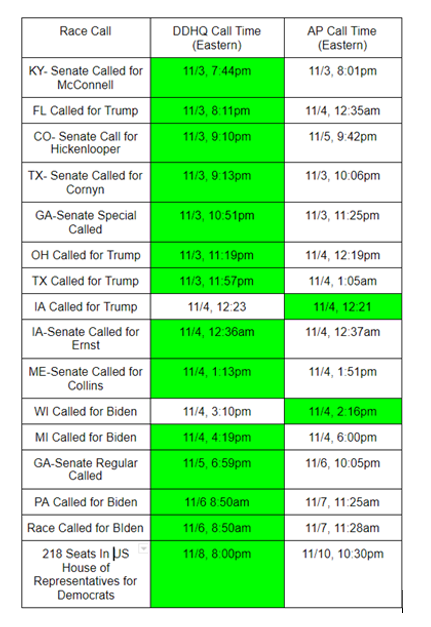One of the most important considerations in choosing an election results source is race calls. We know your brand is on the line every time we make a call. We take a great deal of pride in our accuracy and our speed. Our ability to collect results faster means we’re able to make accurate calls first.
In November 2020, Decision Desk HQ met the challenge head on with an unmatched record of speed and accuracy.

That trend continued in January 2021, when we were the first to call both Senate runoff elections in Georgia, along with control of the US Senate.
Being right means taking the necessary time, even if it means not being first.
A case in point from November was the Arizona presidential contest. We weren’t the first but we’re proud of our process. Since it has drawn so much attention, we thought we’d walk you through how and when we came to make that call so you have a better understanding of what you’re getting when you choose Decision Desk HQ as your results provider.
Preparation for election night begins months in advance. Our call team members are expected to have a deep level of pre-existing knowledge about each state and district they are responsible for. To that background they add current information about the state of the electorate, the candidates involved, and trends in each state or district. They track and analyze mail and early voting data in the weeks before Election Day. They need to have this background so that they can analyze the constantly updating election night returns coming in from around the county in real time and put it in the proper context.
In the case of Arizona, we knew a number of things going into election day:
- While a traditionally Republican state, it has drifted into purple territory recently.
- In 2016 Donald Trump won the state but by a narrower margin than Republicans had previously.
- The state elected a Democratic Senator in 2018.
- Polling showed it to be a close race (the final DDHQ polling average had Biden +2.6) and one that would need to be watched carefully.
Arizona voters had made extensive use of early voting prior to the pandemic and that was expected to increase in November. Given the state’s long history of pre-election day voting, Arizona provides a lot of voter data compared to other states. We were tracking that data very closely leading into election night. That fact was vital to when we made our call.
As expected, pre-election day voting was higher than normal in Arizona. Using data supplied by the state we knew the partisan breakdown of voters who had requested absentee ballots, what counties they were in, whether or not they had returned the ballot, and as we’ll show in a second, crucially when they returned the ballot.
In the first drops of returns on election night (in-person early voting, day of voting, and the first tranche of mail-in absentee voting) Joe Biden had a sizable lead over Donald Trump. It was a lead large enough to have our call team begin to look at the state as a potential election night call.
That trigged a discussion among our analysts who had a relatively brief discussion before deciding the race would not be callable on election night, and probably not for days.
Why did we reach that conclusion? Our Arizona team lead had done his homework. The early absentee returns were indeed favoring Joe Biden, as expected. The catch was by tracking the partisan breakdown of absentee requests and importantly when they were returned, it was clear that there would be a substantial upswing in Trump’s fortunes in the state in the coming days.
While Democrats were highly motivated to vote by mail and early, by tracking data other than votes reported on election night, we knew there was an upswing in requests and ballot returns by Republicans in the last two weeks prior to election day. There was also a slight swing back to Democrats in the final day or two. We also knew that Arizona counties process, count, and report absentee returns roughly inline with when they are received.
Putting all those pieces together we knew a few things:
- Biden would have a substantial election night lead.
- There would be a swing to Trump as the counting went on because of the expected Republican lead in ballots that were received and processed later in the process.
- The number of votes outstanding and the margin Trump would have to win them by (60-62%) was well within the range of what was possible.
- Even if Trump took the lead (which he never did) on the strength of the later mail vote, that might not be enough given the final tranche of provisional votes would not be Trump-leaning
In short, it was clear to us that Biden’s early lead of nearly 200,000 votes on election night was going to shrink substantially, if it held up at all (he eventually won by roughly 11,000 votes).
After the returns played out as we expected with only the winner unknown until the end, we were the first by roughly an hour to call the race among those who didn’t on election night, at 10:29 pm on November 12th. At this point, it was clear that Trump had fallen just short of what he needed to gain in the post-election night tabulated vote, and the outcome was assured.
For more information about our services and how you can carry the fastest, most accurate results, contact us at:
or call
888-412-9998
